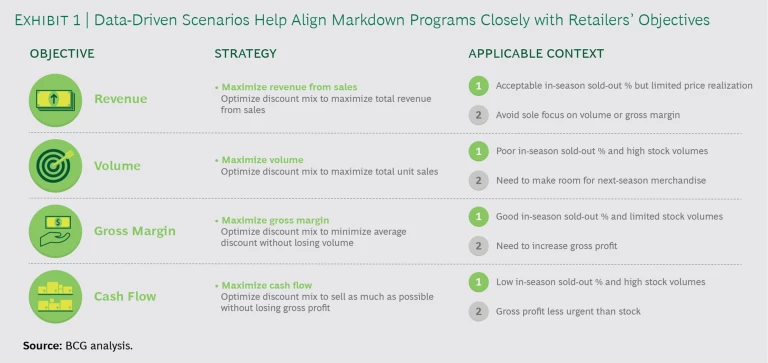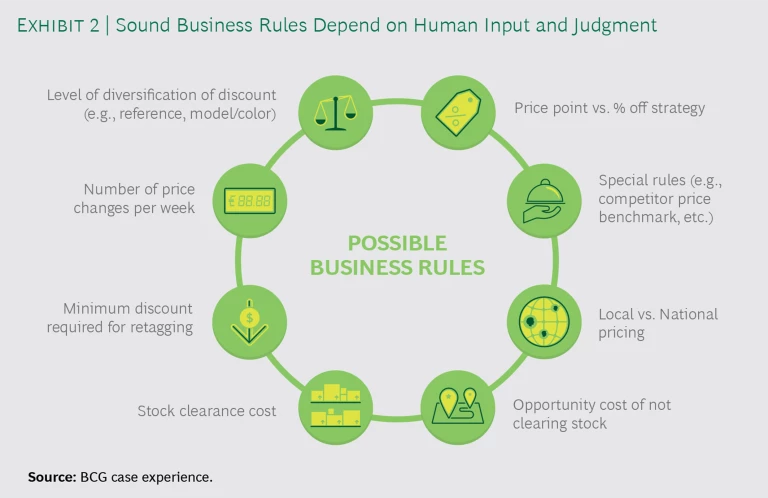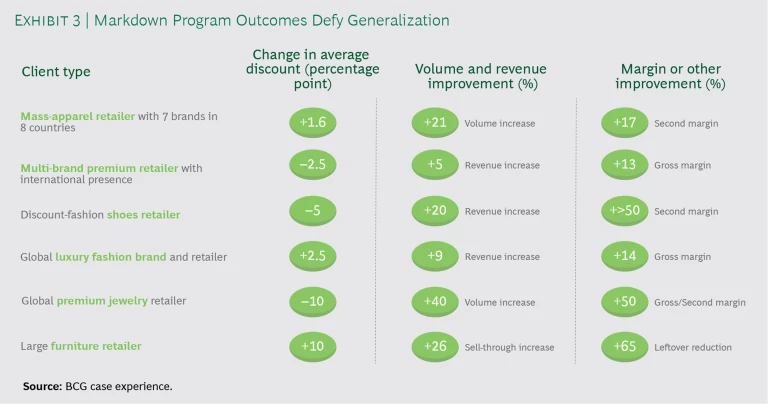Each year, fashion retailers around the world invest more than $1 trillion in their in-season and end-of-season markdown programs, traditionally designing and scaling these programs on the basis of experience, individual perceptions, and simple analyses. The problem with this strategy is that it attempts to solve a high-stakes math problem without using much math, resulting in one-size-fits-all markdown levels of mixed effectiveness. For example, a retailer might offer a simple, across-the-board markdown of 50% in order to clear inventory, and perhaps increase the discount level in subsequent weeks. That approach is easy to communicate and will boost sales volumes, but it carries a dangerous hidden cost: steep margin declines that could put profitability at risk. The question becomes how retailers can reliably determine the right markdowns to achieve their business goals.
The answer lies in harnessing advanced analytics—big data, pricing algorithms, and machine learning—to make stronger decisions on how to offer markdowns that are appealing to consumers and lucrative for retailers. Given the high stakes, advanced analytics provide a superior way to take the industry dynamics of seasonality, rapidly changing tastes, and inventory constraints into account.
Our experience with more than 20 projects in the past 18 months shows that this approach to defining discount levels, made possible by data science only recently available to retailers, can boost gross margins by 10% to 20% for in-season and end-of-season sales programs.
Of course, a keen sense of style makes fashion retailers attractive. The support of high-powered advanced analytics, however, makes them money.
The Fashion Retailer’s Playbook for Using Advanced Analytics
Fashion retailers operate in a challenging business environment. Much of their merchandise is seasonal, with fixed amounts of perishable inventory, and they face a constant influx of new products that have no historical data for analysis or comparison. Under these conditions, it has been risky but nonetheless reasonable for retailers to rely on experience, rules of thumb, and rough analyses to plan their seasonal sales.
A keen sense of style makes fashion retailers attractive. The support of high-powered analytics makes them money.
Today’s data science offers fashion retailers a better way. A highly structured, two-phase process supports the preparation and management of a markdown program. The first phase, comprising the three steps described below, allows the retailer to estimate consumers’ behavior during sales, prepare forecasts, and define the best discount grid by product. The second phase offers retailers the opportunity to adapt their markdown programs in real time.
Matching Products. This first step is necessary in end-of-season sales to predict the performance of new collections—which have no sales history—based on the performance of past ones. It begins with an analysis of pre-markdown sales patterns at the SKU level, in addition to an analysis of the historical performance data for items with a commercial path resembling those SKUs. The objective is then to identify clusters of SKUs from previous seasons with similar pre-markdown sales patterns so that current products can be matched accordingly. Advanced analytics makes this step more efficient and robust, but its strongest impact comes in the second and third steps.
Quantifying Demand. A demand forecasting model can help teams understand how the sales volume of a product reacts to changes in price at any point in time. Through this model, teams can also account for such factors as seasonality, promotional intensity, traffic, and stock-outs. For SKUs or selections that are price-inelastic, large markdowns will have little positive impact on sales volumes and a significant negative effect on margins. But for elastic SKUs or selections, slight markdowns can have a large impact on volume with minimal margin declines. The demand forecasting model will look at previous seasons’ SKU data to quantify the demand for the coming season, resulting in better-informed pricing decisions.
Creating and Choosing Scenarios. The third and final step in this phase puts the demand forecasting model to use. This step makes it possible to estimate sales volume for each SKU at the various discount percentages per sales week, and to use those results to create a considerable number of markdown scenarios. The team can then choose scenarios on the basis of its business targets. The two most common targets are improving (or maximizing) margins and generating working capital.
Exhibit 1 gives an overview of possible strategies retailers can use to reach various objectives and the contexts in which it makes sense to pursue these objectives. For example, some retailers will want to design a markdown program that prioritizes maximizing gross profit in the sale period without volume loss. Others will want to prioritize increasing sell-through and reducing leftovers without surrendering margin. The first objective makes sense when a selection has sold well at its regular price and residual stock for an end-of-season sale is limited, or when a well-defined clearance path for residual stocks exists, such as a proprietary outlet. However, when a selection has not sold well and residual stocks are high, programs should instead be designed to clear the merchandise from inventory and drive volume as much as possible, while ensuring the smallest sacrifice of gross profit. The final output of this first phase is an exact discount grid by item and store.
One fashion retailer conducted this process by compiling and comparing two years of daily transaction data by store, SKU, and ticket, so that it could observe customer behavior in pre- and in-promotion periods. Beyond the price and volume data, the retailer also examined data on available stock, replenishments, and up to two dozen merchandise attributes (size, style, color, in-store placement, and so on) depending on the selection.
The team then defined the parameters for each scenario, including start and end dates, whether the program is in-season or end-of-season, the target to optimize (such as gross margin, sales volume, or working capital), and finally the business rules, such as the number of price changes and the form of discount (percentage, amount, or price point). In this instance, the retailer chose to make no more than two price changes during the sale period and decided to have a uniform approach to markdowns in a product category to simplify in-store communication and avoid customer confusion. These decisions ensured the retailer had clear markdown rules and a set of well-defined constraints to assess cost-benefit implications, as shown in Exhibit 2.
Real-Time Course Corrections
The start of the live campaign triggers the second phase of the markdown process. As sales data continues to flow in by store and SKU, machine learning improves the performance of the algorithms that read and react to markdown scenarios, providing increasingly sophisticated and accurate recommendations in real time. With this technology, the retailer is able to review and adjust the initial discount grid during the sale. Exhibit 3 shows how the discount program—in terms of average overall discount and change in desired target metric—can vary significantly by retailer.
The fact that the results seem to defy generalization underscores the crucial advantage of conducting advanced analyses and the need for doing so. Rather than applying conventional wisdom or rules of thumb, a retailer can design a unique, optimal markdown program for its circumstances immediately, based on a set of factors whose values might look very different in the next sales period.
When it comes to real-time program adjustments, online businesses have the advantage over brick-and-mortar stores, which are constrained by operational needs. Online retailers can automatically improve their strategy with continuous price changes dictated by rotations at the SKU level, and in more sophisticated cases, personalize markdowns at the customer level.
Finally, the fashion retailers who have successfully launched advanced markdown programs realize that the largest implementation hurdles are personal, not technical or analytical. Change management has served as the linchpin across the many projects we have worked on. Translating these programs into live action in stores involves dedicated leadership, additional training and cascading of best practices, as well as new decision-making processes.
Rather than applying rules of thumb, a retailer can design a unique, optimal markdown program for its circumstances immediately.
The Macro Benefits of Advanced Analytics
Advanced analytics are often praised for what they can help achieve at the micro level. For example, it is empowering for a retailer to know with confidence that the best initial discount on one brand of jeans (MSRP of $24.95 with 3,245 pieces still in stock) is 40% when the spring sale begins. But the use of advanced analytics also offers the retailer the following benefits at the macro level:
- Optimizing Targets for a Full Product Life Cycle. Advanced analytics, by nature, improve through continued application. This means that their use allows a fashion retailer to optimize a product or selection across its life cycle, not just for an isolated promotion. Insights from analyses provide input into strategic planning, as well as procurement and merchandising decisions beyond the promotional period at hand.
- Leaving the Right Work to Humans. The technology is important, but the human factor remains critical when using advanced analytics, which complement existing expertise and experience by supporting the retail team’s art with science. Internal teams still need to define precise rules to guide algorithms and codes, and implementing recommendations in real life at the store level can work only in partnership with staff at the point of sale. The sale also requires consistent communications and displays, contributions that intelligent machines cannot make. Finally, the sale requires critical supervision and intervention to ensure that it remains true to its targets.
- Developing New Skills. A markdown optimization program will help a fashion retailer develop digital skills and apply advanced analytics to many other areas, such as overall pricing management, allocation and replenishment, and customization. For retailers embarking on a digital transformation—or already in the midst of one—applying advanced analytics to markdowns helps them explore and better understand the potential of analysis tools.
“The Sale” is a time-honored ritual for retailers and consumers alike, signaled by long lines and heavy foot traffic, regardless of weather or the time of day. Historically, merchandisers have known what sells, but now, thanks to the insights brought by advanced analytics, they can reliably predict how much will sell, when it will sell, and how much it will sell for, ensuring a financially appealing ritual for all parties involved.









